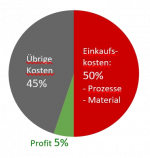Digitization of procurement processes strengthens the company's competitiveness (introductory part)
 Procurement controls at least 50% of a company's total costs, and in the automotive industry up to 80%.
Procurement controls at least 50% of a company's total costs, and in the automotive industry up to 80%.
At the same time, the purchasing department suits ideally for the digitalization of its processes.
The question therefore arises:
What is the best way to begin the digital transformation of procurement?
Existing ERP systems are lagging behind the latest methods of procurement optimization. Many startups in the IT industry have recognized this gap and developed digital procurement platforms. They are Internet-based, use cloud technology, and complement ERP systems with the best of the breed procurement methods.
However, these platforms have their price, which not every company is willing to pay. So, we have developed our Promitea cloud platform according to these principles to enable SMEs to benefit from digital transformation as well:
- Focusing on the essential functions that achieve savings of > 80% with < 20% expenditure
- Procurement department do not need external consultants and introduce Promitea with existing staff in the shortest possible time
- The ROI of the implementation project could be over 500% in the first year!
Promitea functions already enable seamless integration not only in SMEs but also in multi-billion €/year companies. How did we achieve it?
Procurement departments mostly divides their activities into the following areas:
- Strategic purchasing typically concerns "A" products and the most relevant suppliers.
- Operational procurement focuses on so-called leverage products ("B" products) for direct spend, with high unit prices or purchased volumes.
- Catalog procurement deals with "C" products with a focus on standard products for indirect spend.
Promitea offers the following specific methods corresponding to these three areas.
Find the more detailed descriptions below:
By using Promitea in these three core areas of procurement, significant savings can be achieved quickly, effectively, and without risk.
Once the basis for the digital transformation of procurement has been laid, there is room for further optimization. The data obtained using the above-mentioned methods helps to refine procurement instruments to exploit even the latest improvement potentials and further strengthen the role of procurement in the company.
Dr. František Bumba



